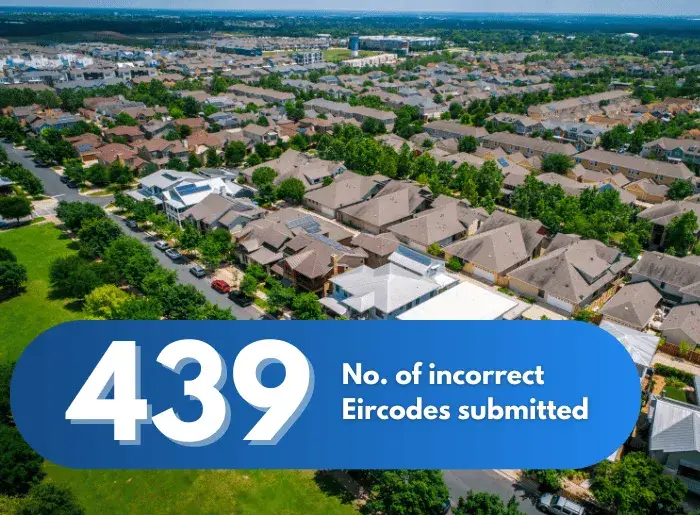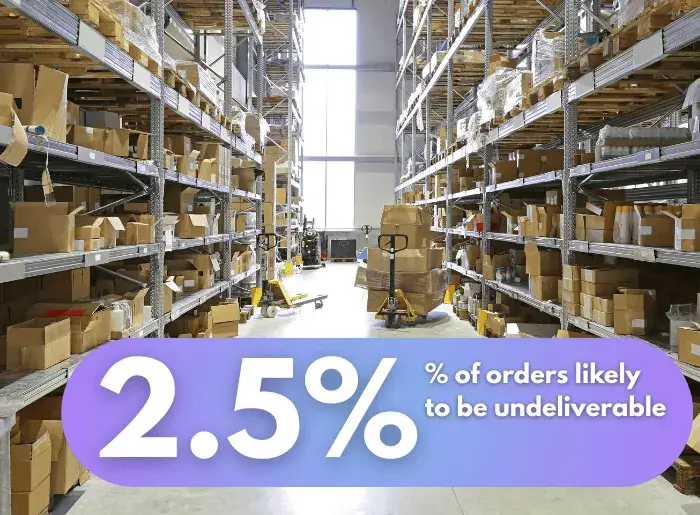A day in the life of 50,000 addresses

e-Commerce address analysis
We recently wrote about the importance of making the connection between delivery issues and poor address data. But it’s difficult to illustrate that point without providing any data to back it up.
So here is that data …
We work with many Irish businesses that use our API to capture and validate hundreds of thousands of addresses every single day. From this, we analysed a random sample of 48,101 over a 24-hour period* to understand how address fields are being submitted —and why clean address data is essential at every step of the e-Commerce fulfillment process.
In most cases, addresses are entered with the help of autocomplete—customers start typing and select from suggested results. But for the addresses in this sample, customers manually typed the full address into a form. We then applied validation after submission to analyse how these addresses were formatted, structured, and completed.
Here’s what we found:
Eircode submission rate
In 88% of cases, customers provided an Eircode when entering their address for an online order. This is good news for Irish retailers as the Eircode adoption rate continues to increase. In early 2020, it was claimed that only one-third of Irish consumers regularly used their Eircode when providing an address. That statistic has since increased dramatically, with many businesses now using Eircode data as a unique address identifier when providing various services.
While the high number of Eircodes provided by customers was undoubtedly positive—42,500 of 48,101—1% (439) of these were actually incorrect. This is where address validation becomes critical, and where we step in to make the correct amendments. Incorrect Eircodes can occur for a number of reasons, such as typos or mistakenly using an Eircode from an old address.

Providing the wrong Eircode might seem like a small mistake—but every character matters. Even a tiny error can send a parcel miles off track.
Take this rural address for example (and we’ve got plenty of those in Ireland):
Ballyblake, Curracloe, Co. Wexford. Its correct Eircode is Y21 NT95. Now change that slightly to Y21 NY95 or Y21 NT96, and you’re in a completely different place:
- NT96 points to Ballymurray, around 13 km away
- NY95 is in Ballyhogue, nearly 20 km from the intended destination.
These are easy mistakes to make—‘T’ and ‘Y’ sit side by side on the keyboard. And while these Eircodes look similar, they lead to entirely different locations, causing confusion for couriers and potential delays for customers.
When the Eircode and address don’t align, real-time validation plays a critical role in catching and correcting those mismatches—before delivery goes off course.
Addresses without an Eircode
As mentioned above, 88% of the addresses we encountered did include an Eircode, while 12% (5,601) did not. Of that 12%, a further 2.5% (1,158) addresses were actually incomplete, or missing vital information such as house numbers or street names. This means that the issue wasn’t just about the absence of Eircodes—many of the addresses themselves were also incomplete or incorrect.

Without an address validation solution in place, this problem could easily be missed and the orders shipped to these customers would likely go undelivered. Being able to pass this type of valuable information back to our customer helps to prevent such issues, enabling them to contact the customer for further clarification before the order is shipped.
Orders we helped to deliver
We fixed address issues for over 16% of the online orders (7,721). This included correcting spelling mistakes, adding vital missing address information, and fixing formatting problems.
By appending missing Eircodes, correcting Eircodes, and fixing other address problems, our address validation solution helped to improve deliverability of just over 11,000 (23%) online orders. That’s nearly one-quarter of the entire order volume we looked at. Now we’re really starting to see the true impact that poor address data can have on e-Commerce operations.

The reality of these results
This analysis highlights the benefits of an address validation solution to reduce delivery issues. Yet many retailers are not availing of these services, or they may be using free or cheap solutions such as Google that do not offer the data accuracy needed to combat these problems.
The address data quality of this sample would have been substantially improved if our address autocomplete solution was used to capture the addresses.
As mentioned in our previous post, address entry errors are common—whether it’s an error on the consumer side or a poorly constructed form by the retailer, etc. Our analysis proves shows that this isn’t a trivial problem, and up to a quarter of online orders are at risk of having deliverability issues because of poor address data.
Conclusion
The data highlights the need for robust address capture and validation methods to ensure accurate data collection. Without this, delivery issues will continue and customer experience will suffer. Retailers should implement a trusted address validation solution; otherwise online address forms will continue to produce incomplete and inaccurate addresses.
*transactions processed on March 20, 2025.